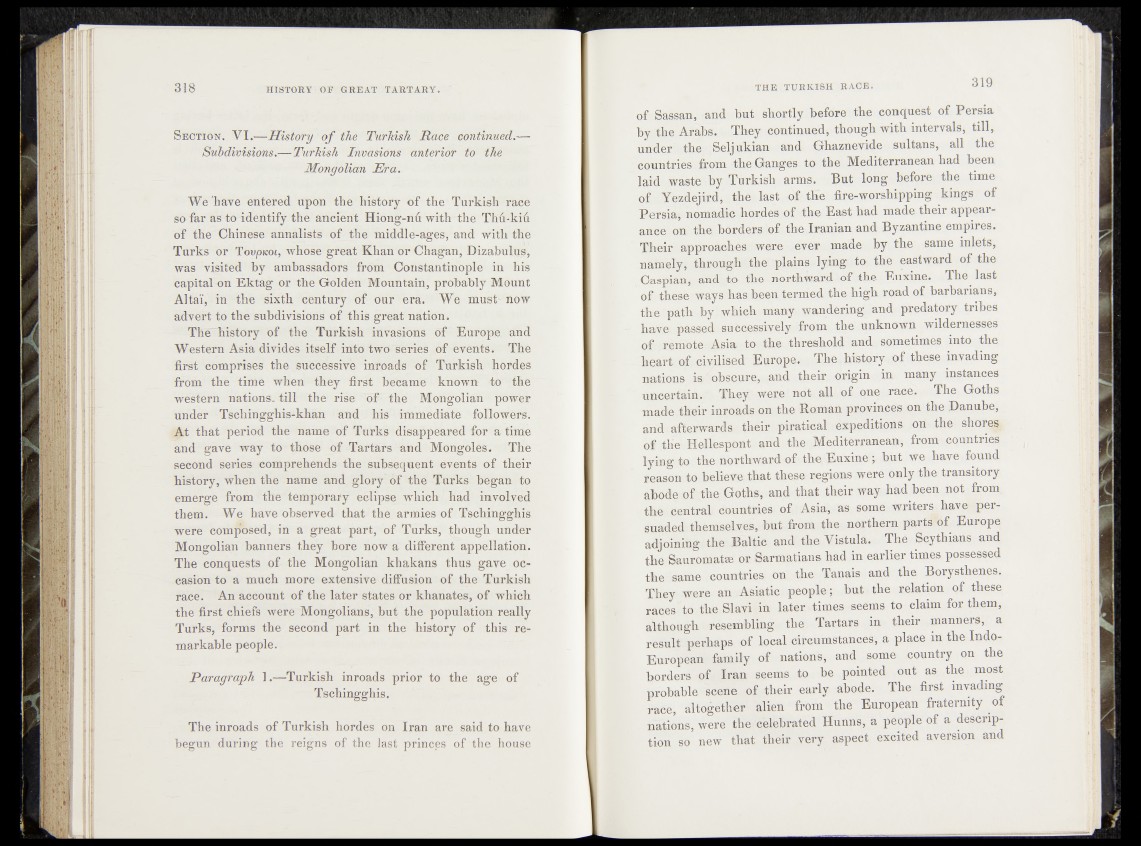
Section. VI.—-History of the Turkish Race continued.-1-
Subdivisions.—Turkish Invasions anterior to the
Mongolian Mr a.
We 'Lave entered upon the history of the Turkish race
so far as to identify the ancient Hiong-nfi with the Thû-kid
of the Chinese annalists of the middle-ages, and wÉl!th||
Turks or Toupicot, whose great Khan or Chagan, Dizabulus,
was T)y ambassadors from <^hstantinobl4#'iii his
capital on Ektag or the Golden Mountain, probably Mount
Altaï, in the sixth century of our era. We must- now
advert to the subdivisions of this great nation.
The-history of the Turkish invasions bf Europe, and
Western Asia divides itself into two' Series of e Verte. Thé
first comprises the-successive inrpads of Turkish hordes
from thé time when they first became known- -to, 'the
western nations, till the rise ‘uF the Mongolian p’owb^
under Tschingghis-khan and his immediate ^foilowii^
At that period the name of Turks disappeared for a time
and gave way to those of Tartars and Mongoles. The
second series comprehends the subsequent events-of their
history, when the name and glory of the Turks began t©
emerge from the temporary eclipse which had involved
them. We have observed that the armies oF Tschingghis
were composed, in a great part, of Turks, though unddi’
Mongolian banners they bore now a different appellation.
The conquests of the Mongolian khakans thus gave occasion
to a much more extensive diffusion of the Turkish
race. An account of the later states or khanates, of which
the first chiefs were Mongolians, but the population really
Turks, forms the second part in the history of this remarkable
people.
Paragraph 1.—Turkish inroads prior to the age of
Tschingghis.
The inroads of Turkish hordes on Iran are said to have
begun during the reigns of the last princes of the house
of Sassan, and but shortly before the conquest of Persia
by the Arabs. They continued, though with intervals, till,
under , the Selj ukian and Ghaznevide sultans, all the
countries from the Ganges to the Mediterranean had been
laid waste by Turkish: arms. But long before the time
of Yezdejird, the last of th'e .fire-worshipping kings of
Persia^ nomadic hordes|pf the East had made their appearance
on the borders of the Iranian and Byzantine empires.
Their approaches were ever made by the same inlets,
namely, through fhe^plainsriying, to the eastward of the
y Caspian, and to the-northward of the Euxine. ; The last
of these*ways has been|©rmed- the high road of barbarians,
the path' by whichr#any.’ wandering^ .and predatory tribes
have, passed successively from the unknown wildernesses
©^remote Asia. .-tov.the threshold and sometimes into the
-heart o£ civilised Europe. The history of these invading
nations is*'obscure,. and their origin in many instances
uncertain.' They were not- all of one,.race.. The Goths
made their inroads on the Roman provinces on the Danube,
and afterwards their piratical expeditions .on- the shores
of the Hellespont and the Mediterranean, from4 countries
lying to the northward of . th<iEuxine ; bust we have found
reason to believe that these regions were only the transitory
abode; of the Goths, and that their way- had been*, not from.
countries o f ; Asia, as some writer^haveg persuaded
themselves, but from the: northern parts‘of Europe
adjoining the Baltic and the Vistula. The, Scythians and
tb&sSaurom atse or Sarmatiansuhad in earlier times possessed
the same countries on the Tanais and the Borysthenes,.
They were an Asiatic people; but the relation of these
races' to th e Slavi in lateritimes seems to claim for them,
although resembling the T a r t a r s ^ their manners, a
result perhaps of local circumstances, a place in the Indo-
European family of nations, and some- .country on the
borders of. Iran seems to | be pointed out as the most
probable scene of-their early abode. The first invading
race, altogether alien from the European fraternity of
nations, were the'celebrated Hunns, a people a description
so new that their very aspect excited aversion and